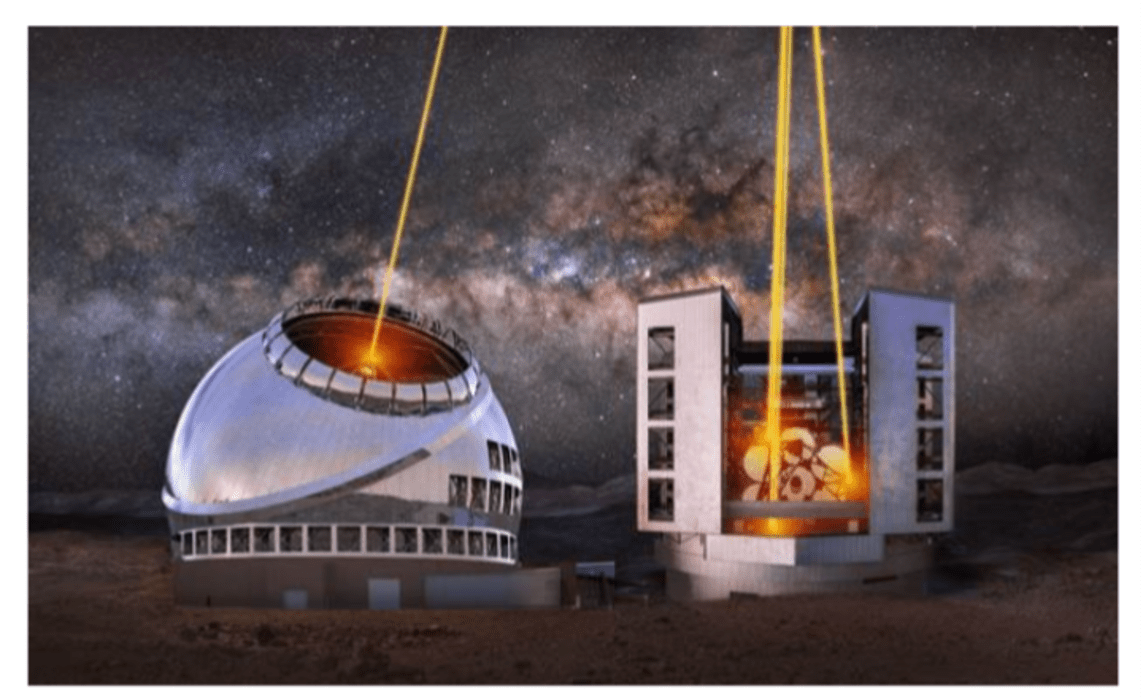News Excerpt:
Indian researchers have developed an innovative open-source tool to create a comprehensive star catalog for the Adaptive Optics (AO) system of the upcoming Thirty Meter Telescope (TMT).

Thirty Meter Telescope (TMT)
- Design and Purpose: The TMT is designed as a 30-metre diameter primary-mirror optical and infrared telescope, enabling deep-space observations.
- International Collaboration: It is a joint project involving institutions from the U.S., Japan, China, Canada, and India.
- Capabilities: Once operational, it will be the world’s most advanced ground-based observatory for optical, near-infrared, and mid-infrared observations.
- Its unprecedented design will feature unique capabilities for the exploration of black holes, dark matter, and the possibility of life outside the solar system.
- Technological Innovations: The TMT will incorporate the latest advancements in precision control, segmented mirror design, and adaptive optics.
- This will make its images more than four times sharper than the James Webb Space Telescope.
- Segmented Mirror: The primary mirror consists of 492 individual segments, which will be precisely aligned to function as a single 30-meter reflective surface.
- Location: The telescope will be situated on Mauna Kea, an inactive volcano on the island of Hawai’i in the United States.
- India’s participation: Involves three institutes: the Indian Institute of Astrophysics IIA, Bengaluru, the Inter-University Center for Astronomy and Astrophysics (IUCAA), Pune, and the Aryabhatta Research Institute for Observational Sciences (ARIES), Nainital.The India-TMT Coordination Center (ITCC) is headquartered at IIA, Bengaluru.
Ground-Based Astronomy and Atmospheric Distortion:
- The TMT, along with the Giant Magellan Telescope and the European Southern Observatory’s Extremely Large Telescope, represents the future of ground-based astronomy.
- Ground-based telescopes face significant challenges due to atmospheric distortion, which affects image quality.
- This issue is particularly crucial for telescopes like the TMT, which have high light-collection capacities and are sensitive to upper atmospheric disturbances.
- To counteract these distortions, the TMT will utilize an Adaptive Optics System (AOS) that continuously senses and adjusts for atmospheric changes, thereby producing high-quality images.
Adaptive Optics System (AOS) and the Need for NIR Star Catalog:
- The AOS system on TMT, known as the Narrow Field Infrared Adaptive Optics System (NFIRAOS), will be enhanced by a Laser Guide Star (LGS).
- This facility will project up to nine lasers into the sky to create artificial guide stars.
- However, atmospheric turbulence affects these laser beams, making measuring atmospheric tip-tilt uncertain.
- To correct these effects, the AO system requires feedback from three real stars, known as Natural Guide Stars (NGS).
- Simulations indicate that NFIRAOS requires at least three NGS within its field of view, each as bright as 22 magnitudes in the near-infrared J waveband.
- Currently, no such comprehensive catalog of stars exists to provide NGS for all regions of the sky, emphasizing the critical need for the new tool developed by Indian researchers.
Development and Function of the Automated Tool
- Researchers at the IIA in Bengaluru, along with their collaborators, have developed an automated code that serves as an online tool to create a catalog of Near Infrared (NIR) stars.
-
- This code computes the expected near-infrared magnitudes of stellar sources identified in various optical sky surveys using their optical magnitudes.
- Utilizing multi-band optical photometry from the PAN-STARRS telescope, the researchers filtered and identified stars, predicting their near-infrared magnitudes through innovative methods.
- They validated their approach using data from the UKIDSS survey of the United Kingdom Infrared Telescope, achieving over 85% accuracy in their NIR magnitude predictions.
Significance of the Tool:
- This tool will enable the TMT to generate sharper astronomical images by mitigating atmospheric distortion.
- The demonstrated method shows great promise in generating the all-sky catalog of NIR stars needed before TMT’s first run in the next decade.
- The detailed findings of this research were published in the Astronomical Journal which marks a significant advancement in the field of astronomy, offering the potential to greatly enhance the capabilities of the TMT and contribute to groundbreaking discoveries in the years to come.
|
Telescope A telescope is an optical instrument that magnifies and resolves distant objects, allowing detailed observation and study of celestial and terrestrial phenomena. It collects electromagnetic radiation, such as visible light, radio waves, or X-rays, and uses lenses or mirrors to focus the light into an image. Types of Telescopes:
These different types of telescopes extend our observational capabilities across various environments, enabling comprehensive studies of the universe. |


